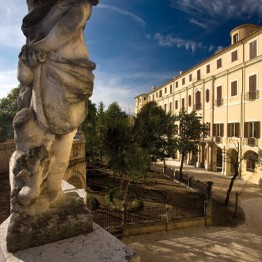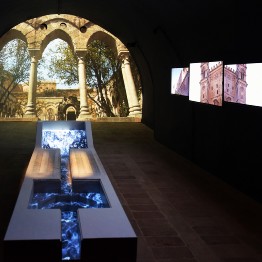Jesi and the birth of Frederick II
Frederick II was born in Jesi on 26 December 1194 in the square dedicated to him where there is also a museum with his name.
As early as 1186, his parents, Constance I and Henry VI, stayed for a few days in Jesi, recognised as friendly town to the empire. On their way down from Milan to Sicily, the couple separated near Piacenza, where Costanza followed a safer route for her condition, with stops in cities loyal to the Swabians.
When she arrived in the Marca, she stopped in Fano, Senigallia, Chiaravalle and Jesi where, in the square then dedicated to Saint Florian, the tent where Frederick was born was set up; a public space, so that everyone could witness the event and clear up any rumours that, both then and later, were raised about Constance's real pregnancy, who gave birth to the heir to the throne at the age of forty, eight years after her marriage to Henry VI.
The event, described by several, often inconsistent sources, says that "citizens and married women and fifteen bishops and cardinals" witnessed the birth, but when Salimbene di Adam later stayed in the Franciscan monastery of St. Mark, he cast shadows on this event. In his Chronicle, the friar wrote about a rumour in town that Frederick was the son of a butcher form Jesi and that Constance had faked both the pregnancy and the birth by hiding the baby under her clothes. Salimbene was supported by Merlin's gloomy predictions, who foretold a "miraculous and unexpected", but misfortune-bearing birth. Joachim of Fiore added to this, describing Constance as possessed by the devil and unaware of her pregnancy, so as to read the emperor's birth as the coming of the antichrist. Salimbene also tells the story of a heated argument between Frederick II and his father-in-law John I King of Jerusalem in which John called the emperor "son of a butcher" and Frederick was ashamed.
A few historians from Jesi, such as Gritio, told greatly detailed stories about two returns of the emperor to his native land, which never actually happened, but were so deeply impressed in popular imagination that the curtain of the Pergolesi Theatre, created by Luigi Mancini in 1850, depicts the emperor's solemn return to Jesi on a white horse.
The only relationship, after his birth, between Frederick and Jesi is the letter, now kept in the Vatican Library, he sent in August 1239. In the midst of his conflict with northern Italy's pro-papal towns, Frederick wrote, by the hand of Pietro della Vigna, a grand and powerful appeal to convince Jesi to leave the Pope and join the imperial cause; an invitation that had the desired effect, as Jesi sided with the Swabians.
The same year, Enzo, Frederick's son and vicar in the Marca, sent a document granting new privileges to Jesi. The town was donated the villas in Ripe and Monte delle Torri (now near Santa Maria Nuova), the castles of Morro, Albarello (now both Morro d'Alba), Monte San Vito and the forest of Castagnola near Chiaravalle, a strategic location to secure Jesi an outlet to the sea.
A journey through Jesi’s history and art
The Cathedral of St. Septimius, dedicated to the co-patron (the other is St. Florian), first bishop of Jesi in the 4th century, has a late nineteenth century facade which has been repeatedly remodeled since 1200. The St. Florian Complex, with its theatre-studio dedicated to the great actress Valeria Moriconi from Jesi, had been a Romanesque church dedicated to the Saint since 1100. Next to the theatre is the Frederick II Stupor Mundi Museum which displays the life, exploits and faces of the great emperor in 16 multimedia rooms. The same square hosts the Diocesan Museum, with precious examples of sacred art from all over Vallesina. The elegant Palazzo della Signoria, now home of the Library, was the town's Priors residence and was designed by Francesco di Giorgio Martini. Palazzo Bisaccioni is home to the bank Cassa di Risparmio di Jesi and houses the foundation museum with a beautiful nineteenth century, completely intact vault. The top floor houses the headquarters and library of the Frederick II Hoenstauffen Foundation, which has been studying and promoting the figure of the emperor for decades. Palazzo Pianetti is home to the town art gallery, with Lorenzo Lotto's canvases and the outstanding eighteenth-century rococo stucco gallery. The top floor houses a large collection of contemporary art. The ground floor houses the Archaeological Museum with testimonies from all over the middle Vallesina. The educational Museum of the Arts of Printing tells the story of the lively printing activity born in Jesi with Federico Conti who in 1472 printed one of the oldest editions of the Divine Comedy. The late eighteenth century Pergolesi Theatre (dedicated to the composer Giovan Battista Pergolesi from Jesi) is an architectural and cultural gem, the heart of the town. The church of St. Mark is a massive example of medieval art in the Marche region, with the typical Franciscan monasteries' vaults painted in blue with stars. Outside the walls is the church of Santa Maria del Piano, which has eighteenth century shapes now, although its medieval origins are still preserved in its peculiar underground architecture with a carved sarcophagus; elements that reveal the power and wealth of this settlement, which ruled part of Vallesina since the early Middle Ages.
The IME - The Marches Food and Wine Institute recommends:
Jesi’s early purple artichoke
A garden deli, Jesi's early artichoke is part of the Marches' typical produce and boasts a centuries-old tradition, as evidenced by a few documents dating back to the late 18th century. Its distinguishing features, besides its production area, are its colour, which mixes different shades of green and purple, its small size, and its early harvest, which usually begins in March. These artichokes are very tasty and several recipes tie them to the land, such as the "artichoke casserole", a typical Marche side dish.
Jesi’s early cauliflower
This is the name of the local variety of cauliflower, as it is the first to be sold in markets compared to those grown in other parts of Italy. Also known as snail cabbage because of its beautiful architectural inflorescences with pointed corymbs, this cabbage is very sturdy and can withstand pests and water shortages. It quickly conquered northern European markets as early as 1910, with Germany being the first.
Over time, genetic improvement has also affected the colour of its corymb, which has gone from yellowish to white to meet market demands. However, its distinguishing earliness and sturdiness have remained the same.
Info:
Musei Civici di Palazzo Pianetti
Museo Federico II - Stupor Mundi
Sale Museali di Palazzo Bisaccioni



